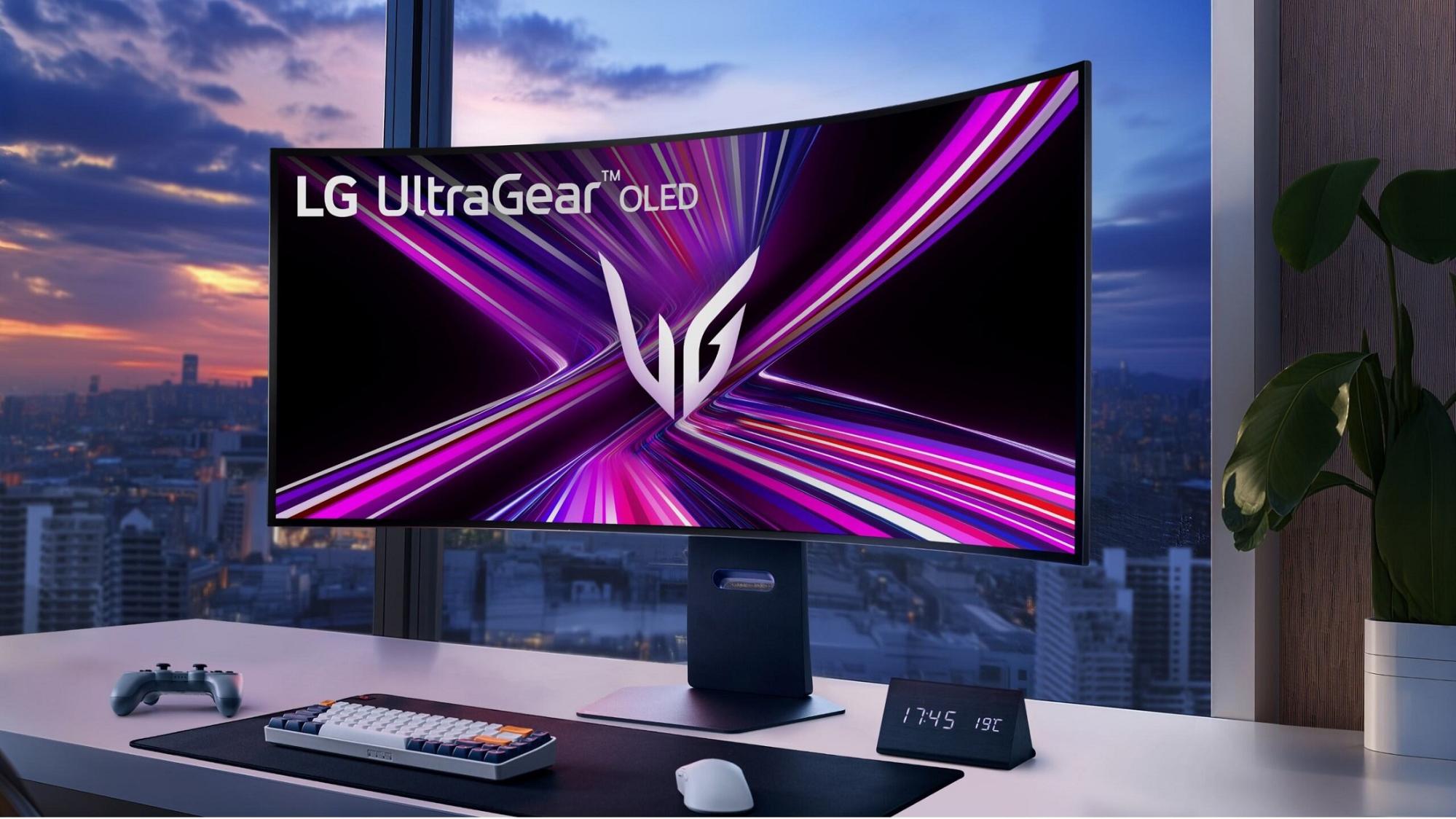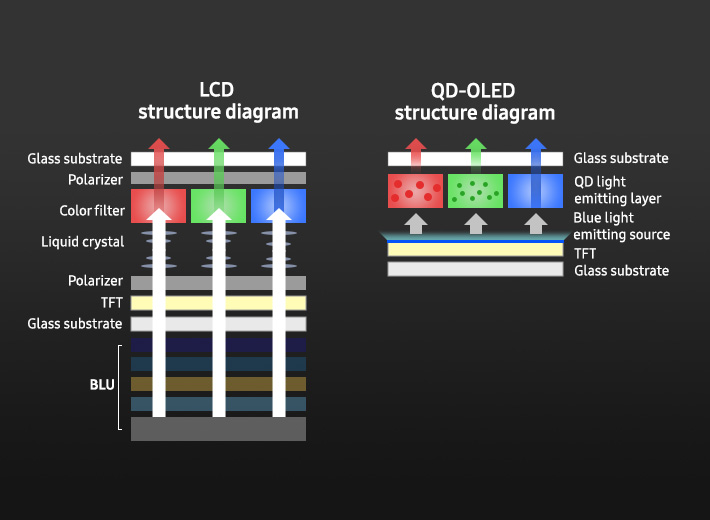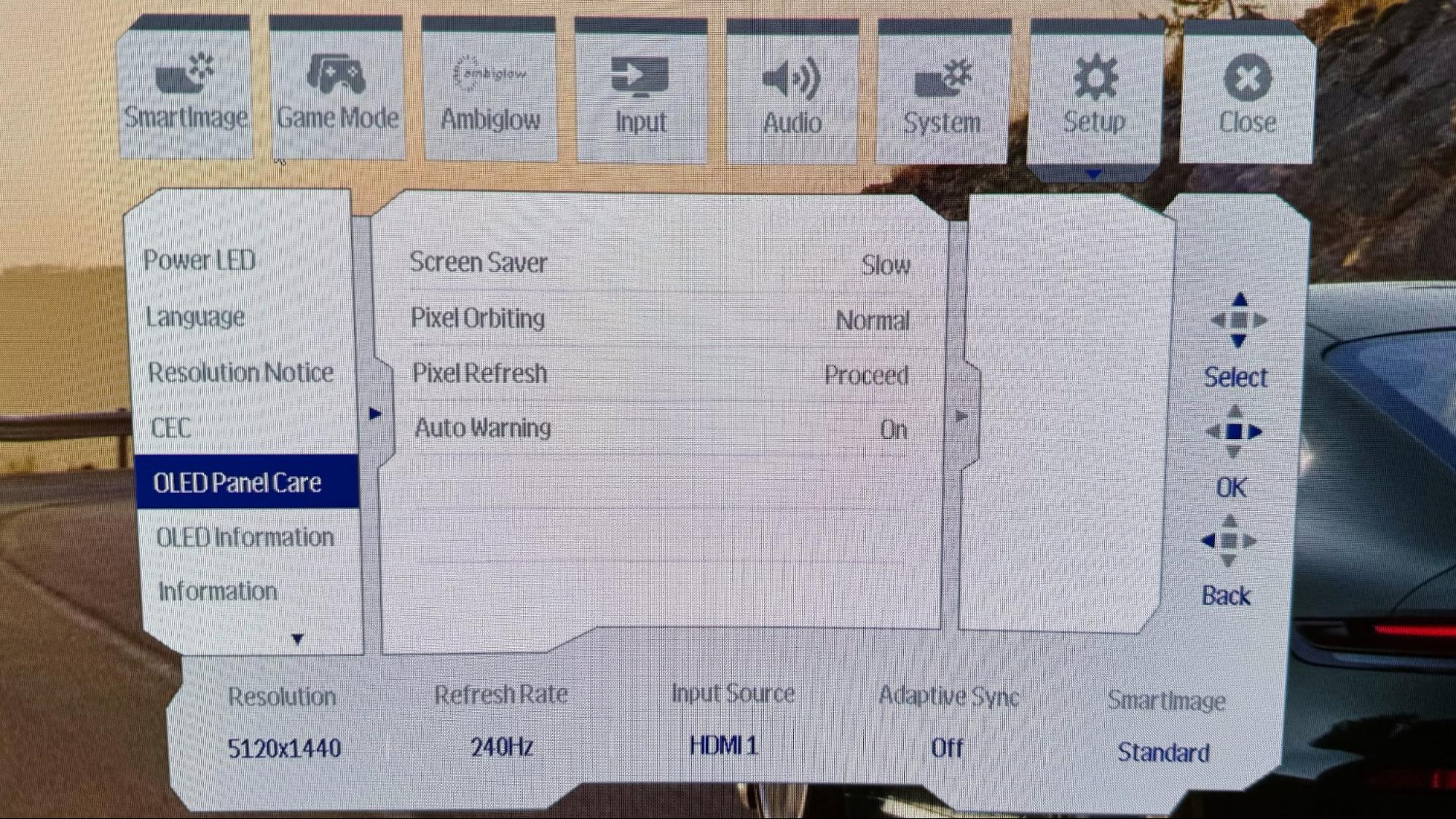WOLED vs QD-OLED Monitors – which panel technology is better?
There’s a difference between White OLED and Quantum Dot OLED.

Organic light-emitting diode (OLED) technology has swept through the computing space, delivering a superior viewing experience in devices ranging from smartphones to tablets to laptops to the best OLED gaming monitors. When it comes to PC monitors, there are generally two popular options available to consumers: WOLED and QD-OLED.
WOLED Panels
WOLED stands for White OLED and has been popularized by LG. WOLEDs feature four subpixels: red, green, blue, and white. WOLEDs do away with the individual emitters for the red, green, and blue filters, and rely on a single layer that emits white light. The white subpixel doesn’t have a filter, so it lets the white light from the emitter pass through uninterrupted.

This arrangement allows WOLEDs to carry the same benefits of traditional OLEDs – namely, per-pixel control of light output resulting in incredible contrast – but it also has an added advantage. By using a single white emitter to pass through the color filters, you don’t run into a problem where individual emitters for red, green, and blue age at different rates, resulting in color shifting and burn-in.
WOLED technology doesn’t completely eliminate burn-in or image retention on monitors, but it can lessen the severity of the phenomena over time.
Another thing to consider with WOLEDs, however, is that the use of a filter has some downsides. While you can achieve superbly bright whites thanks to the white light emitter, the color filters can blunt that light production, reducing color volume.
QD-OLED Panels
Quantum-Dot OLED (QD-OLED) swaps the white light emitter for a blue light source and was developed by Samsung Display. There are then red and green subpixels – the blue subpixel is just an extension.
Each red and blue subpixel is infused with red and blue quantum dots, respectively, over the blue emissive layer. The energy-efficient nature of quantum dots (they can pass through 99% of the light they receive) means that QD-OLED panels can reach higher peak brightness levels and produce superior color, thanks to not needing to deal with the color filters in a WOLED panel.
Get Tom's Hardware's best news and in-depth reviews, straight to your inbox.

Another advantage is that since you don’t need to drive the white light, which also must contend with the color filters, QD-OLEDs are also more power efficient.
Our testing found that QD-OLED monitors have consistently delivered superior color volume compared to WOLED monitors. For example, we’ve seen QD-OLED panels achieving around 110 percent coverage of DCI-P3 for superbly saturated color in SDR and HDR content. And the AOC AG346UCD is officially the most colorful OLED monitor we’ve tested to date, coming oh so close to perfection with 100.95% sRGB volume.
Burn-in/Image Retention Mitigation
Burn-in results where an image on a monitor is retained and can be seen when content is being displayed. An example would be a static ticker bar at the bottom of the screen on a TV news channel (a la CNN or Fox News) or a status panel/health bar in a game. If that bar is left in the same position without any mitigation strategies in place, you would see that image appear when switching to media content that, for example, features a light background.
When we test OLED gaming monitors, we don’t have them in our possession long enough to perform any endurance testing to check for image burn-in. However, manufacturers have implemented comprehensive mechanisms in firmware to mitigate burn-in on modern OLED, WOLED, and QD-OLED panels.

For example, Philips uses pixel shifting to move displayed content 1 pixel (and up to 8 pixels) up/left/right/down to reduce burn-in. This can occur automatically once per 80 seconds. You can also manually trigger a manual clearing of burn-in that occurs. LG offers Clear Panel Noise, Screen Shift features as well. Samsung panels also offer Pixel Shit, Adjust Logo Brightness, pixel refresh, and screen optimization features.
While it’s impossible to state that an OLED panel will never experience one hint of burn-in/image retention over its useful life, these features significantly lower the risk.
Bottom Line
It’s hard to find a bad OLED monitor these days, as the contrast ratio, color volume, and response times put them in a league far surpassing their VA and IPS counterparts. Pricing is the only major downside to going with any OLED panel over, say, an IPS equivalent.
You pay a significant pricing premium to enjoy the tangible benefits of OLED. But once you commit to OLED, you’ll have to decide how much of a hit you want to take to your wallet. WOLED-based monitors are generally cheaper, but you have to contend with the limits on brightness and color volume. QD-OLED monitors aren’t hindered by those limits, but you will pay an even dearer premium to enjoy those fruits.

Brandon Hill is a senior editor at Tom's Hardware. He has written about PC and Mac tech since the late 1990s with bylines at AnandTech, DailyTech, and Hot Hardware. When he is not consuming copious amounts of tech news, he can be found enjoying the NC mountains or the beach with his wife and two sons.
-
Zaranthos When will we see red LED technology so we can stop ruining our eye health? With LED technology replacing most indoor lighting our exposure to a one sided light spectrum all day long (unless you take more frequent breaks outdoors for real sunlight exposure) is literally ruining most people's eyesight over time.Reply
https://pmc.ncbi.nlm.nih.gov/articles/PMC7738953/ -
The Historical Fidelity Reply
The reason why LED lights use blue emitters is because phosphor crystal and/or quantum dot crystals can be layered on top to transform a portion of blue light into the longer wavelength cyan, green, yellow, orange, and red wavelengths. Cheap LED lights use only yellow phosphor to mimic a certain color temperature so steer away from any LED bulbs that are rated below 90 CRI (Color Rendering Index, 100 = incandescent). For reasonable cost per bulb, I am very fond of the Sylvania TruWave bulbs as they use a blue emitter that produces multiple wavelengths of blue at 50% less intensity of normal single wavelength blue emitters and much more closely follow the true black body emission spectrum of incandescent bulbs. However, if you want the best LED bulbs, then I recommend 95+ CRI bulbs that are additionally rated 95+ R9 (R9 is a specific test of a bulbs ability to render deep red color). The Soraa Vivid series of bulbs are some of the best I’ve seen that are readily available and use violet emitters instead of blue emitters and instead add a blue phosphor to the top layer to precisely control blue output. Their light output truly recreates the old school incandescent 2700k bulbs, or 3000k halogen/tungsten bulbs faithfully depending on if you opt for their 2700k or 3000k offerings. If you are looking for a night time bulb that does not produce any blue light, then the Soraa Zeroblue series is the best out there. It is the only no blue output bulbs that still render colors correctly and maintain a true incandescent 2700k color temperature by using a violet emitter and omitting the blue phosphor. If you look at the spectrograph for the Soraa ZeroBlue series, you will notice that the range of blue light that interferes with circadian rhythm (440-490nm) is completely missing. However you will pay an arm and a leg for each bulb.Zaranthos said:When will we see red LED technology so we can stop ruining our eye health? With LED technology replacing most indoor lighting our exposure to a one sided light spectrum all day long (unless you take more frequent breaks outdoors for real sunlight exposure) is literally ruining most people's eyesight over time.
https://pmc.ncbi.nlm.nih.gov/articles/PMC7738953/ -
Zaranthos Very good info. The bulbs in my office and work area are Sylvania TruWave which I really like. I didn't know about the Soraa bulbs so I will have to check those out. Thanks.Reply -
Pierce2623 Reply
Blue LEDs are fine at a lower more comfortable CCT. They can replicate incandescent light if that’s your thing or they can just give you really good color rendering at a more comfortable CCT like 3500k-4000k.Zaranthos said:When will we see red LED technology so we can stop ruining our eye health? With LED technology replacing most indoor lighting our exposure to a one sided light spectrum all day long (unless you take more frequent breaks outdoors for real sunlight exposure) is literally ruining most people's eyesight over time.
https://pmc.ncbi.nlm.nih.gov/articles/PMC7738953/ -
nitrium "coming oh so close to perfection with 100.95% sRGB volume"Reply
I doubt you can go beyond 100%, which would be perfect....(?), -
nitrium "Samsung panels also offer Pixel Sh*t"Reply
I mean I had to block that out with a * or it would be auto flagged. Your proof-reader is not doing their job. -
The Historical Fidelity Reply
No problem, I’m a huge LED geek. I make custom flashlights using raw LED emitters.Zaranthos said:Very good info. The bulbs in my office and work area are Sylvania TruWave which I really like. I didn't know about the Soraa bulbs so I will have to check those out. Thanks.
Soraa is a company started by the inventor of the blue LED emitter because he saw a need for high quality white light LED bulbs, which is why he invented the violet LED emitter for his Soraa bulbs.